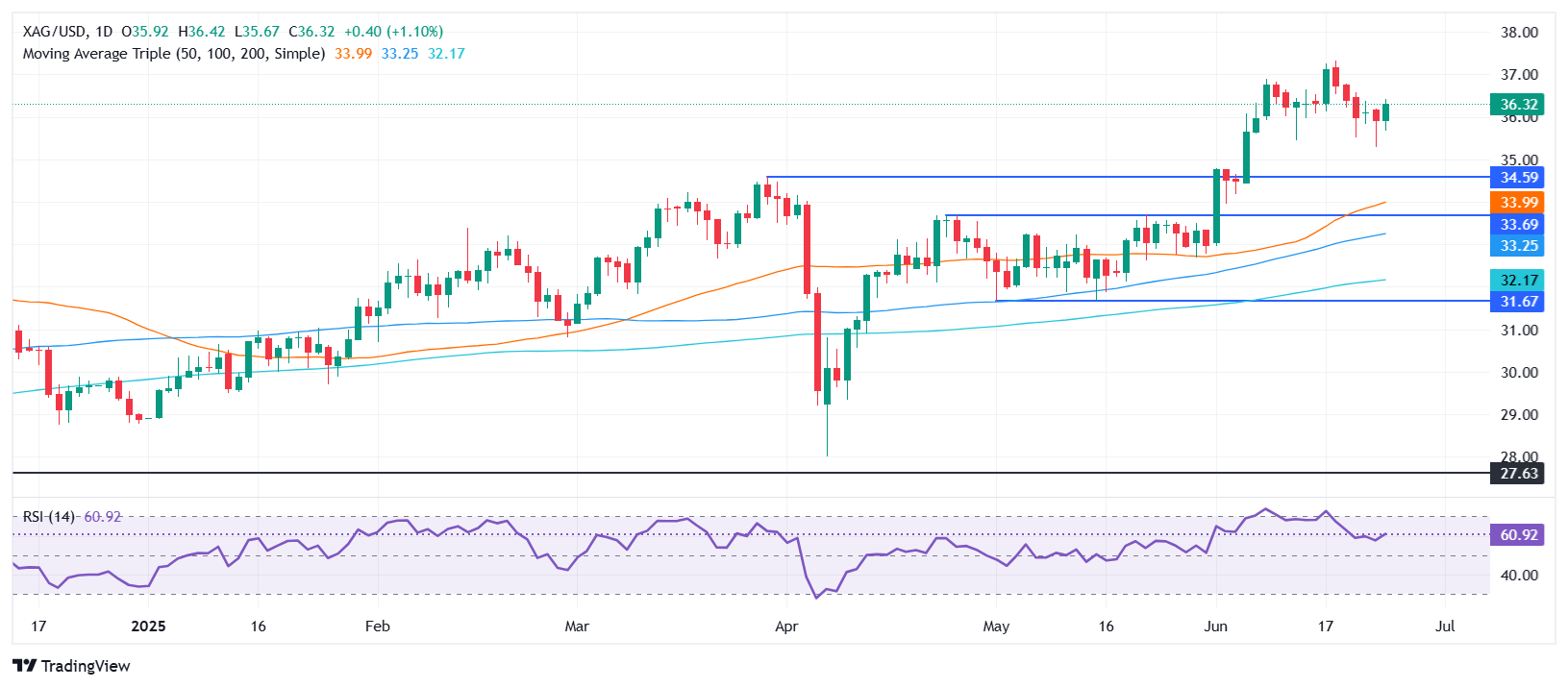Silver Price Forecast: XAG/USD climbs above $36.00 on weak US Dollar
- Silver rebounds from $35.68, trades near $36.25 as month-end flows weigh on US Dollar.
- Bullish ‘morning star’ forms; RSI stays positive, signaling potential upward momentum.
- Resistance at $36.42 and $37.31; support at $35.29 and 50-day SMA at $33.95.
Silver price advances by nearly 1% on Wednesday, as the US Dollar depreciates due to month-end flows, along with expectations of falling US Treasury yields. At the time of writing, XAG/USD trades at $36.25, after bouncing off daily lows of $35.68.
XAG/USD Price Forecast: Technical Analysis
Even though Silver dipped to a new two-week low of $35.29 last Friday, the grey metal found bids, which pushed the spot price above $36.00 and formed a ‘morning star’ three-candle chart bullish pattern. Despite this, the Relative Strength Index (RSI) remained flat in bullish territory, suggesting that the pair is neutral to upwardly biased. If XAG/USD clears key resistance levels, then the uptrend could resume.
The first key area of interest will be the June 20 high of $36.42. Once surpassed, the next stop would be $37.00, followed by the multi-year high of $37.31.
On the flip side, if XAG/USD tumbles below the June 24 low of $35.29, expect a pullback all the way towards the 50-day Simple Moving Average (SMA) at $33.95.
XAG/USD Price Chart – Daily

Silver FAQs
Silver is a precious metal highly traded among investors. It has been historically used as a store of value and a medium of exchange. Although less popular than Gold, traders may turn to Silver to diversify their investment portfolio, for its intrinsic value or as a potential hedge during high-inflation periods. Investors can buy physical Silver, in coins or in bars, or trade it through vehicles such as Exchange Traded Funds, which track its price on international markets.
Silver prices can move due to a wide range of factors. Geopolitical instability or fears of a deep recession can make Silver price escalate due to its safe-haven status, although to a lesser extent than Gold's. As a yieldless asset, Silver tends to rise with lower interest rates. Its moves also depend on how the US Dollar (USD) behaves as the asset is priced in dollars (XAG/USD). A strong Dollar tends to keep the price of Silver at bay, whereas a weaker Dollar is likely to propel prices up. Other factors such as investment demand, mining supply – Silver is much more abundant than Gold – and recycling rates can also affect prices.
Silver is widely used in industry, particularly in sectors such as electronics or solar energy, as it has one of the highest electric conductivity of all metals – more than Copper and Gold. A surge in demand can increase prices, while a decline tends to lower them. Dynamics in the US, Chinese and Indian economies can also contribute to price swings: for the US and particularly China, their big industrial sectors use Silver in various processes; in India, consumers’ demand for the precious metal for jewellery also plays a key role in setting prices.
Silver prices tend to follow Gold's moves. When Gold prices rise, Silver typically follows suit, as their status as safe-haven assets is similar. The Gold/Silver ratio, which shows the number of ounces of Silver needed to equal the value of one ounce of Gold, may help to determine the relative valuation between both metals. Some investors may consider a high ratio as an indicator that Silver is undervalued, or Gold is overvalued. On the contrary, a low ratio might suggest that Gold is undervalued relative to Silver.

